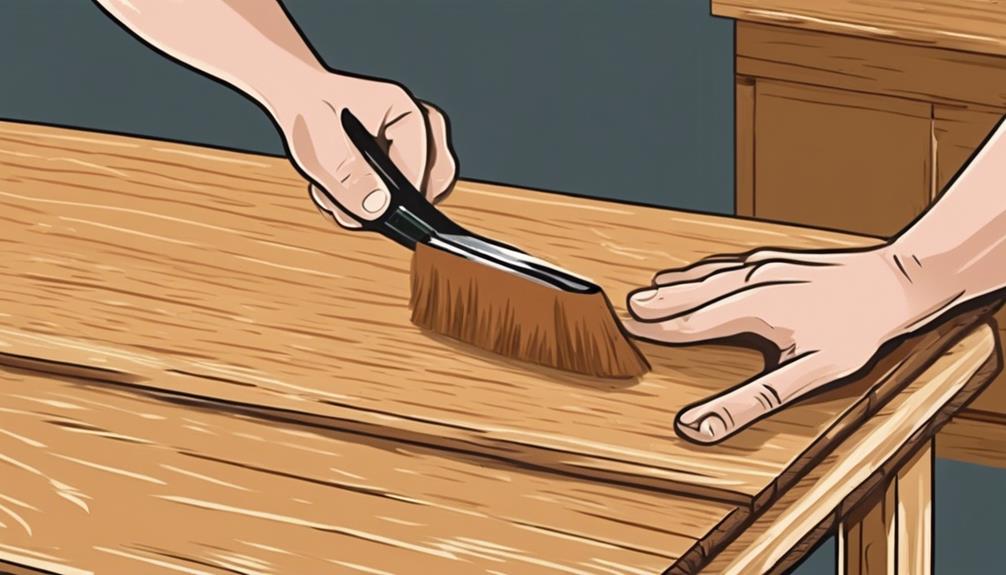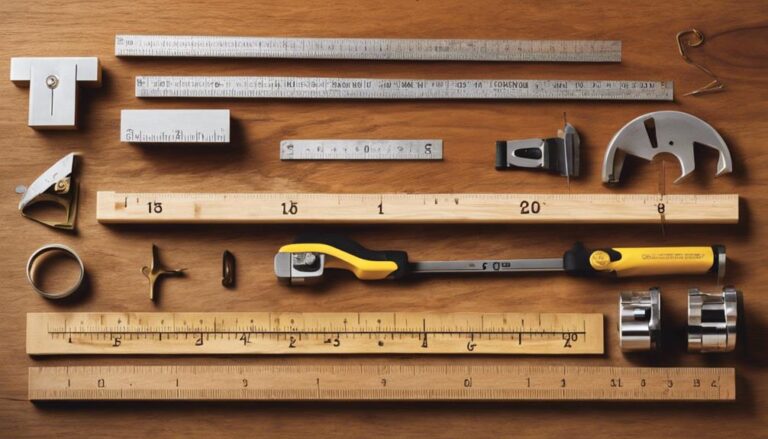Mastering measurements, wielding woodworking tools with precision, and creating seamless joins are just the start of your journey into carpentry.
As you embark on this path, you’ll find that understanding the nuances of wood types and mastering the art of accurate marking are crucial first steps.
But what comes next? How do you transition from cutting straight lines to constructing sturdy, functional pieces that stand the test of time?
Contents
Key Takeaways
- Selecting the right wood type is crucial for project durability and aesthetics.
- Accurate measurement and clear marking are foundational for precision in carpentry.
- Knowledge and proper usage of essential tools like saws and tape measures enhance project quality.
- Mastering precision techniques, such as reading tape measures and using squares, minimizes material waste and saves time.
Understanding Wood Types

Selecting the right wood type, whether it’s a softwood like pine or a hardwood like oak, is crucial for the durability and aesthetics of your carpentry project. Understanding the characteristics of both hardwoods and softwoods is key to making informed decisions.
Hardwoods, known for their durability and rich appearance, are ideal for furniture and indoor projects. Softwoods, on the other hand, are often more affordable and easier to work with, making them great for framing and outdoor use, thanks to certain types’ resistance to the elements.
Your wood selection impacts not just the project’s final look but its longevity as well. Whether you’re building a deck or a bookshelf, knowing the differences between these wood types ensures your carpentry projects stand the test of time.
Measuring and Marking

Before you make your first cut or join, it’s vital to choose the right tools for measuring and marking your materials. Precision in these early steps ensures your project pieces fit together perfectly.
You’ll learn how essential it is to measure twice and mark clearly, setting the stage for excellence in all your carpentry work.
Choosing Right Tools
To ensure your carpentry projects are both accurate and high-quality, it’s crucial to start by choosing the right measuring and marking tools. In the realm of carpentry, precision and accuracy aren’t just buzzwords; they’re foundational skills that distinguish amateur work from professional results.
By selecting proper tools like tape measures for distance and metal squares for angles, you lay the groundwork for successful woodworking. Remember, precision marking is your roadmap for cutting and shaping wood with consistency. Understanding the significance of these steps is essential for ensuring your project’s dimensions and alignments are spot on.
Efficiently selecting your measuring and marking tools isn’t just about getting it right; it’s about setting the stage for excellence in every piece you create.
Precision Techniques
Having chosen the right tools, it’s now essential to master precision techniques in measuring and marking to elevate your carpentry projects. Precision techniques aren’t just about using a tape measure or metal squares; they’re about ensuring your projects come together seamlessly and professionally.
- Learn to read a tape measure accurately: Understanding its markings is crucial for accurate measurements.
- Use metal squares for precise angles: This ensures your corners are square and your project looks professional.
- Double-check measurements: This practice minimizes the wastage of materials and saves time.
- Master various marking techniques: Proper marking is key to precise cutting and shaping, leading to a professional finish.
Adopting these precision techniques will significantly enhance the quality of your carpentry projects.
Basic Tool Usage

Next up, let’s tackle the basics of tool usage, focusing on selecting the right tools and practicing safe handling.
Knowing which tool to use and how to use it safely is key to your success and safety in carpentry.
We’ll guide you through the essentials of tool selection and the best practices to keep you safe while you work.
Tool Selection Essentials
Selecting the right tools, such as hammers, saws, and tape measures, is critical for beginners in carpentry to ensure efficient and accurate work. Understanding the purpose and function of each tool not only aids in carrying out tasks more effectively but also lays a strong foundation for advancing your carpentry skills. Here’s what you need to focus on:
- Hammers: Essential for driving nails and fitting parts.
- Saws: Crucial for cutting wood to the right dimensions.
- Tape Measures: Key for precise measurements and layouts.
- Chisels and Levels: Important for achieving clean cuts and ensuring evenness.
Mastering these carpentry tools will enhance the precision and quality of your projects, making your journey into carpentry a successful one.
Safe Handling Practices
Before diving into your next carpentry project, it’s crucial to gear up with the right safety equipment to prevent any injuries. Always wear goggles, gloves, and closed-toe shoes.
Using tools safely means making sure to learn the carpentry basics, like keeping your work area well-lit and organized. This not only helps with efficiency but also keeps you safe. Secure your workpiece with clamps or a vise to keep it stable.
When using any tool, remember that right-hand placement is key. Your grip should be firm, with your index finger pointed along the tool’s body for control. This technique prevents tired wrists or sore hands over time.
Practice good posture and move ergonomically to avoid strain. These steps are essential for mastering safe handling practices in carpentry.
Cutting and Shaping

To master carpentry, you’ll need to learn the art of precisely cutting and shaping wood, ensuring your projects have clean, professional finishes. Achieving this requires:
- Precision and accuracy: Always aim for accurate cuts. Whether you’re using a hand saw or power tools, precision is key.
- Proper hand control: Especially important when handling tools like miter saws, where stability ensures straight cuts.
- Choosing the right saw: Use circular saws for long, straight cuts and jigsaws for intricate curves.
- Efficient nail hammering techniques: Essential for tasks requiring strong, stable support.
Mastering these skills isn’t just about making cuts; it’s about executing with confidence and control, ensuring every piece fits perfectly and every finish is as intended.
Joinery Techniques
Mastering joinery techniques is essential for creating strong, lasting connections in your woodworking projects. These methods, including dovetail, mortise tenon, and biscuit joints, are foundational for crafting durable joints in furniture and structures.
Precision in these techniques ensures seamless connections and upholds the structural integrity of your creations. You’ll rely on specialized tools like chisels, routers, and saws to execute intricate and accurate joints.
By understanding and applying various joinery techniques, you elevate the quality and craftsmanship of your woodworking endeavors. Remember, the key to success lies in meticulous attention to detail and the use of the right tools.
This approach won’t only enhance the aesthetic appeal of your projects but also their longevity and functionality.
Finishing Touches

Once you’ve assembled your woodworking project, the final step is applying the finishing touches to elevate its beauty and durability. This phase of finish carpentry isn’t just about aesthetics; it’s also about protecting your hard work.
Here’s how to cap off the building process like a pro:
- Apply the minimum amount of varnish, paint, or stain; it prevents drips and ensures a smoother finish.
- Sand surfaces smooth before finishing to achieve that perfect cut-to-finish look.
- Add decorative elements like trim or molding to help keep it stable and enhance the aesthetic appeal.
- Seal joints and edges with wood filler or caulk to prevent future damage and create a seamless look.
Conclusion
Wrapping it up, you’ve got the basics covered. Understanding wood types sets the stage while measuring and marking ensure precision.
Mastering tools, cutting, and shaping refine your craft. Joinery techniques bring pieces together, creating strong bonds.
Don’t skimp on the finishing touches—they make your work stand out. With these skills in your toolkit, you’re well on your way.
Practice diligently, keep learning, and remember, every expert was once a beginner. Now, go build something amazing with confidence and pride.






